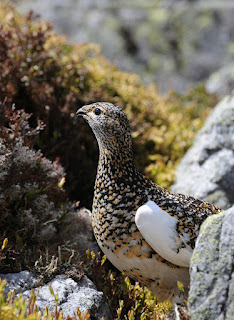Bird banding in Mallee
Last weekend I was out banding birds in mallee woodland at Charcoal Tank Nature Reserve, near West Wyalong. The trip was organised by Mark Clayton who has been banding birds there for over twenty years and seen big changes in bird numbers there as the habitat has changed over the dry years and now a wet one. One bird we caught was a fine adult male Common Bronzewing, above. This is a common and widespread Australian species of pigeon, readily identified by the male's pale forehead and rich rusty red underwing.
We caught three Painted Button-Quail which have bred well in the tall grasses that have grown throughout the east in the high rainfall of the 2010-2011 spring. This bird is the more brightly coloured female with chestnut neck, back and coverts. The male which incubates and rears the chicks is smaller and more buff in colour.
The grasses are about a metre tall, and have cast their seeds, but still provide a thick understory to the red ironbark trees. In previous years the ground has been open, with a thin covering of leaf litter and sparse grasses and shrubs.
We also caught a mallee heath specialist species, the Shy Heathwren. This is closely related to the Chestnut-rumped Heathwren, which it clearly resembles. That species is however, more associated with coastal heaths and scrub farther east. The Shy Heathwren fills this habitat niche from near West Wyalong and to the west.
The bird we caught was an adult female, identified by the pale eyestripe and dull wing flash of white and dark feathers. The male has more a pronounced white eyestripe and wing flashes.
While we were catching birds in nets, we ourselves were repeatedly caught in the large anchor strands of cobwebs spun by orb-weaving spiders. Here a female sit in the centre of her web while the smaller male sits quietly on the edge. She is quite likely to eat him after they have mated.
















